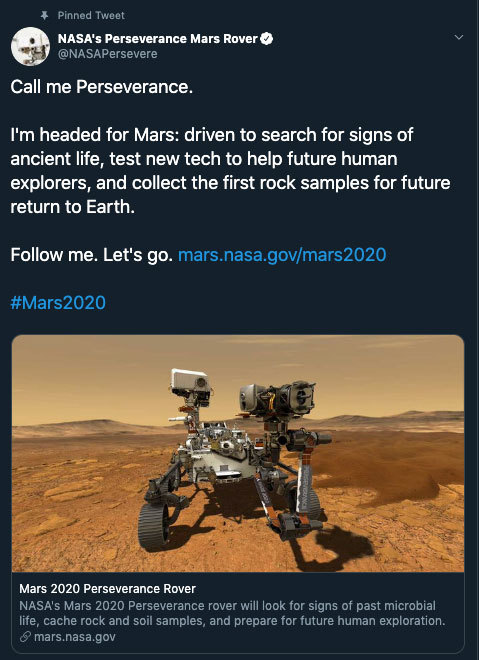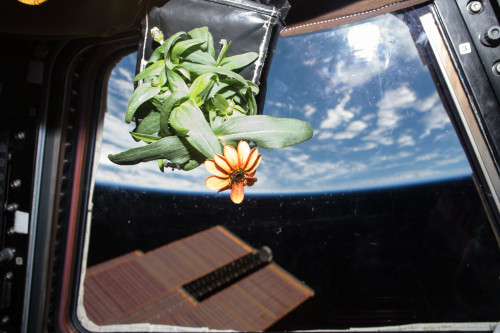The Meaning Of Color In Hubble Images: An Interactive Slideshow That Illustrates How The Hubble Space






The Meaning of Color in Hubble Images: An interactive slideshow that illustrates how the Hubble Space Telescope incorporates light in multiple wavelengths to produce it’s stunning imagery.
More Posts from Fillthevoid-with-space and Others

Allow us to reintroduce someone … the name’s Perseverance.
With this new name, our Mars 2020 rover has now come to life! Chosen by middle school student Alex Mather, Perseverance helps to remind ourselves that no matter what obstacles we face, whether it’s on the way to reaching our goals or on the way to Mars, we will push through. In Alex’s own words,
“We are a species of explorers, and we will meet many setbacks on the way to Mars. However, we can persevere. We, not as a nation but as humans, will not give up. The human race will always persevere into the future.”
Welcome to the family. ❤️
Make sure to follow us on Tumblr for your regular dose of space: http://nasa.tumblr.com.



Take a moment, look outside your window. 🌷🌼
Today is the #FirstDayOfSpring in the Northern Hemisphere, also known as the vernal equinox.
#DYK Earth’s tilted axis causes the season? Throughout the year, different parts of Earth receive the Sun’s most direct rays. So, when the North Pole tilts toward the Sun, it’s summer in the Northern Hemisphere. And when the South Pole tilts toward the Sun, it’s winter in the Northern Hemisphere.
These images are of Zinnias. They are part of the flowering crop experiment that began aboard the International Space Station on Nov. 16, 2015, when NASA astronaut Kjell Lindgren activated the Veggie system and its rooting “pillows” containing zinnia seeds.
Make sure to follow us on Tumblr for your regular dose of space: http://nasa.tumblr.com.
Why Webb Needs to Chill
Our massive James Webb Space Telescope is currently being tested to make sure it can work perfectly at incredibly cold temperatures when it’s in deep space.
How cold is it getting and why? Here’s the whole scoop…
Webb is a giant infrared space telescope that we are currently building. It was designed to see things that other telescopes, even the amazing Hubble Space Telescope, can’t see.

Webb’s giant 6.5-meter diameter primary mirror is part of what gives it superior vision, and it’s coated in gold to optimize it for seeing infrared light.

Why do we want to see infrared light?
Lots of stuff in space emits infrared light, so being able to observe it gives us another tool for understanding the universe. For example, sometimes dust obscures the light from objects we want to study – but if we can see the heat they are emitting, we can still “see” the objects to study them.
It’s like if you were to stick your arm inside a garbage bag. You might not be able to see your arm with your eyes – but if you had an infrared camera, it could see the heat of your arm right through the cooler plastic bag.

Credit: NASA/IPAC
With a powerful infrared space telescope, we can see stars and planets forming inside clouds of dust and gas.

We can also see the very first stars and galaxies that formed in the early universe. These objects are so far away that…well, we haven’t actually been able to see them yet. Also, their light has been shifted from visible light to infrared because the universe is expanding, and as the distances between the galaxies stretch, the light from them also stretches towards redder wavelengths.
We call this phenomena “redshift.” This means that for us, these objects can be quite dim at visible wavelengths, but bright at infrared ones. With a powerful enough infrared telescope, we can see these never-before-seen objects.

We can also study the atmospheres of planets orbiting other stars. Many of the elements and molecules we want to study in planetary atmospheres have characteristic signatures in the infrared.

Because infrared light comes from objects that are warm, in order to detect the super faint heat signals of things that are really, really far away, the telescope itself has to be very cold. How cold does the telescope have to be? Webb’s operating temperature is under 50K (or -370F/-223 C). As a comparison, water freezes at 273K (or 32 F/0 C).
How do we keep the telescope that cold?
Because there is no atmosphere in space, as long as you can keep something out of the Sun, it will get very cold. So Webb, as a whole, doesn’t need freezers or coolers - instead it has a giant sunshield that keeps it in the shade. (We do have one instrument on Webb that does have a cryocooler because it needs to operate at 7K.)

Also, we have to be careful that no nearby bright things can shine into the telescope – Webb is so sensitive to faint infrared light, that bright light could essentially blind it. The sunshield is able to protect the telescope from the light and heat of the Earth and Moon, as well as the Sun.

Out at what we call the Second Lagrange point, where the telescope will orbit the Sun in line with the Earth, the sunshield is able to always block the light from bright objects like the Earth, Sun and Moon.

How do we make sure it all works in space?
By lots of testing on the ground before we launch it. Every piece of the telescope was designed to work at the cold temperatures it will operate at in space and was tested in simulated space conditions. The mirrors were tested at cryogenic temperatures after every phase of their manufacturing process.

The instruments went through multiple cryogenic tests at our Goddard Space Flight Center in Maryland.

Once the telescope (instruments and optics) was assembled, it even underwent a full end-to-end test in our Johnson Space Center’s giant cryogenic chamber, to ensure the whole system will work perfectly in space.

What’s next for Webb?
It will move to Northrop Grumman where it will be mated to the sunshield, as well as the spacecraft bus, which provides support functions like electrical power, attitude control, thermal control, communications, data handling and propulsion to the spacecraft.

Learn more about the James Webb Space Telescope HERE, or follow the mission on Facebook, Twitter and Instagram.
Make sure to follow us on Tumblr for your regular dose of space: http://nasa.tumblr.com.
In Conversation with the Sun: Parker Solar Probe Communications
Our Sun powers life on Earth. It defines our days, nourishes our crops and even fuels our electrical grids. In our pursuit of knowledge about the universe, we’ve learned so much about the Sun, but in many ways we’re still in conversation with it, curious about its mysteries.

Parker Solar Probe will advance this conversation, flying through the Sun’s atmosphere as close as 3.8 million miles from our star’s surface, more than seven times closer to it than any previous spacecraft. If space were a football field, with Earth at one end and the Sun at the other, Parker would be at the four-yard line, just steps away from the Sun! This journey will revolutionize our understanding of the Sun, its surface and solar winds.

Supporting Parker on its journey to the Sun are our communications networks. Three networks, the Near Earth Network, the Space Network and the Deep Space Network, provide our spacecraft with their communications, delivering their data to mission operations centers. Their services ensure that missions like Parker have communications support from launch through the mission.

For Parker’s launch on Aug. 12, the Delta IV Heavy rocket that sent Parker skyward relied on the Space Network. A team at Goddard Space Flight Center’s Networks Integration Center monitored the launch, ensuring that we maintained tracking and communications data between the rocket and the ground. This data is vital, allowing engineers to make certain that Parker stays on the right path towards its orbit around the Sun.

The Space Network’s constellation of Tracking and Data Relay Satellites (TDRS) enabled constant communications coverage for the rocket as Parker made its way out of Earth’s atmosphere. These satellites fly in geosynchronous orbit, circling Earth in step with its rotation, relaying data from spacecraft at lower altitudes to the ground. The network’s three collections of TDRS over the Atlantic, Pacific and Indian oceans provide enough coverage for continuous communications for satellites in low-Earth orbit.

The Near Earth Network’s Launch Communications Segment tracked early stages of Parker’s launch, testing our brand new ground stations’ ability to provide crucial information about the rocket’s initial velocity (speed) and trajectory (path). When fully operational, it will support launches from the Kennedy spaceport, including upcoming Orion missions. The Launch Communications Segment’s three ground stations are located at Kennedy Space Center; Ponce De Leon, Florida; and Bermuda.

When Parker separated from the Delta IV Heavy, the Deep Space Network took over. Antennas up to 230 feet in diameter at ground stations in California, Australia and Spain are supporting Parker for its 24 orbits around the Sun and the seven Venus flybys that gradually shrink its orbit, bringing it closer and closer to the Sun. The Deep Space Network is delivering data to mission operations centers and will continue to do so as long as Parker is operational.
Near the Sun, radio interference and the heat load on the spacecraft’s antenna makes communicating with Parker a challenge that we must plan for. Parker has three distinct communications phases, each corresponding to a different part of its orbit.
When Parker comes closest to the Sun, the spacecraft will emit a beacon tone that tells engineers on the ground about its health and status, but there will be very little opportunity to command the spacecraft and downlink data. High data rate transmission will only occur during a portion of Parker’s orbit, far from the Sun. The rest of the time, Parker will be in cruise mode, taking measurements and being commanded through a low data rate connection with Earth.

Communications infrastructure is vital to any mission. As Parker journeys ever closer to the center of our solar system, each byte of downlinked data will provide new insight into our Sun. It’s a mission that continues a conversation between us and our star that has lasted many millions of years and will continue for many millions more.
For more information about NASA’s mission to touch the Sun: https://www.nasa.gov/content/goddard/parker-solar-probe
For more information about our satellite communications check out: http://nasa.gov/SCaN
Make sure to follow us on Tumblr for your regular dose of space: http://nasa.tumblr.com.
I saw the picture and I thought it was a photo of the space between a Venetian blind and a window frame but no. No. It was a moon between the rings of Saturn.
Does Mars Have Rings? Not Right Now, But Maybe One Day
NASA - Mars Science Laboratory (MSL) patch. March 20, 2017 As children, we learned about our solar system’s planets by certain characteristics – Jupiter is the largest, Saturn has rings, Mercury is closest to the sun. Mars is red, but it’s possible that one of our closest neighbors also had rings at one point and may have them again someday. That’s the theory put forth by NASA-funded scientists at Purdue University, Lafayette, Indiana, whose findings were published in the journal Nature Geoscience. David Minton and Andrew Hesselbrock developed a model that suggests that debris that was pushed into space from an asteroid or other body slamming into Mars around 4.3 billion years ago alternates between becoming a planetary ring and clumping together to form a moon. One theory suggests that Mars’ large North Polar Basin or Borealis Basin – which covers about 40 percent of the planet in its northern hemisphere – was created by that impact, sending debris into space. “That large impact would have blasted enough material off the surface of Mars to form a ring,” Hesselbrock said. Hesselbrock and Minton’s model suggests that as the ring formed, and the debris slowly moved away from the Red Planet and spread out, it began to clump and eventually formed a moon. Over time, Mars’ gravitational pull would have pulled that moon toward the planet until it reached the Roche limit, the distance within which a planet’s tidal forces will break apart a celestial body that is held together only by gravity.
Image above: The image from NASA’s Curiosity Mars rover shows one of Mars’ two moons, Phobos, passing directly in front of the other, Deimos, in 2013. New research suggests the moons consolidated long ago from dust rings around the planet and, in the distant future, may disintegrate into new rings. Image Credits: NASA/JPL-Caltech/Malin Space Science Systems/Texas A&M Univ. Phobos, one of Mars’ moons, is getting closer to the planet. According to the model, Phobos will break apart upon reaching the Roche limit, and become a set of rings in roughly 70 million years. Depending on where the Roche limit is, Minton and Hesselbrock believe this cycle may have repeated between three and seven times over billions of years. Each time a moon broke apart and reformed from the resulting ring, its successor moon would be five times smaller than the last, according to the model, and debris would have rained down on the planet, possibly explaining enigmatic sedimentary deposits found near Mars’ equator. “You could have had kilometer-thick piles of moon sediment raining down on Mars in the early parts of the planet’s history, and there are enigmatic sedimentary deposits on Mars with no explanation as to how they got there,” Minton said. “And now it’s possible to study that material.” Other theories suggest that the impact with Mars that created the North Polar Basin led to the formation of Phobos 4.3 billion years ago, but Minton said it’s unlikely the moon could have lasted all that time. Also, Phobos would have had to form far from Mars and would have had to cross through the resonance of Deimos, the outer of Mars’ two moons. Resonance occurs when two moons exert gravitational influence on each other in a repeated periodic basis, as major moons of Jupiter do. By passing through its resonance, Phobos would have altered Deimos’ orbit. But Deimos’ orbit is within one degree of Mars’ equator, suggesting Phobos has had no effect on Deimos. “Not much has happened to Deimos’ orbit since it formed,” Minton said. “Phobos passing through these resonances would have changed that.” “This research highlights even more ways that major impacts can affect a planetary body,” said Richard Zurek of NASA’s Jet Propulsion Laboratory, Pasadena, California. He is the project scientist for NASA’s Mars Reconnaissance Orbiter, whose gravity mapping provided support for the hypothesis that the northern lowlands were formed by a massive impact. Minton and Hesselbrock will now focus their work on either the dynamics of the first set of rings that formed or the materials that have rained down on Mars from disintegration of moons. Curiosity is part of NASA’s ongoing Mars research and preparation for a human mission to Mars in the 2030s. Caltech manages JPL, and JPL manages the Curiosity mission for NASA’s Science Mission Directorate in Washington. For more about Curiosity, visit: http://www.nasa.gov/msl and http://mars.jpl.nasa.gov/msl/ For more information about NASA missions investigating Mars, visit: https://mars.nasa.gov/ Image (mentioned), Text, Credits: NASA/Laurie Cantillo/Dwayne Brown/JPL/Guy Webster/Purdue University/Steve Tally/Emil Venere/Writer: Brian Wallheimer. Best regards, Orbiter.ch Full article
I still highly recommend this good, beautiful web comic about love in space, and now it's all done! You can read it all.




The final three chapters are up. Read it now.
That’s it folks, On A Sunbeam is over. Though I am pondering a sequel.
Thank you all so much for following along.

The Elephants Trunk in IC 1396 : Like an illustration in a galactic Just So Story, the Elephants Trunk Nebula winds through the emission nebula and young star cluster complex IC 1396, in the high and far off constellation of Cepheus. Of course, the cosmic elephants trunk is over 20 light-years long. This composite was recorded through narrow band filters that transmit the light from ionized hydrogen, sulfur, and oxygen atoms in the region. The resulting image highlights the bright swept-back ridges that outline pockets of cool interstellar dust and gas. Such embedded, dark, tendril-shaped clouds contain the raw material for star formation and hide protostars within the obscuring cosmic dust. Nearly 3,000 light-years distant, the relatively faint IC 1396 complex covers a large region on the sky, spanning over 5 degrees. via NASA
js
-
 colordesigns liked this · 8 years ago
colordesigns liked this · 8 years ago -
 fillthevoid-with-space reblogged this · 8 years ago
fillthevoid-with-space reblogged this · 8 years ago -
 earendil-was-a-cosmologist reblogged this · 9 years ago
earendil-was-a-cosmologist reblogged this · 9 years ago -
 earendil-was-a-cosmologist liked this · 9 years ago
earendil-was-a-cosmologist liked this · 9 years ago -
 gonewiddershins reblogged this · 9 years ago
gonewiddershins reblogged this · 9 years ago -
 kogiopsis reblogged this · 9 years ago
kogiopsis reblogged this · 9 years ago -
 rocky-3 reblogged this · 10 years ago
rocky-3 reblogged this · 10 years ago -
 bistromatic liked this · 10 years ago
bistromatic liked this · 10 years ago -
 burnedhoney reblogged this · 10 years ago
burnedhoney reblogged this · 10 years ago -
 venusianw liked this · 10 years ago
venusianw liked this · 10 years ago -
 venusianw reblogged this · 10 years ago
venusianw reblogged this · 10 years ago -
 luana-the-fallen-angel liked this · 10 years ago
luana-the-fallen-angel liked this · 10 years ago -
 arandomcoyote liked this · 10 years ago
arandomcoyote liked this · 10 years ago -
 frankie-the-fox reblogged this · 10 years ago
frankie-the-fox reblogged this · 10 years ago -
 frankie-the-fox liked this · 10 years ago
frankie-the-fox liked this · 10 years ago -
 bigbadkingboomboo reblogged this · 10 years ago
bigbadkingboomboo reblogged this · 10 years ago -
 kynosourae reblogged this · 10 years ago
kynosourae reblogged this · 10 years ago -
 mentaltypo liked this · 10 years ago
mentaltypo liked this · 10 years ago -
 dearkurisu liked this · 10 years ago
dearkurisu liked this · 10 years ago -
 eltoronavi reblogged this · 10 years ago
eltoronavi reblogged this · 10 years ago -
 eltoronavi liked this · 10 years ago
eltoronavi liked this · 10 years ago -
 moonamaranth liked this · 10 years ago
moonamaranth liked this · 10 years ago -
 peanutbutterfiles liked this · 10 years ago
peanutbutterfiles liked this · 10 years ago -
 gerryo0o liked this · 10 years ago
gerryo0o liked this · 10 years ago -
 themostexcellenthost reblogged this · 10 years ago
themostexcellenthost reblogged this · 10 years ago -
 themostexcellenthost liked this · 10 years ago
themostexcellenthost liked this · 10 years ago -
 imcoolunlikeu liked this · 10 years ago
imcoolunlikeu liked this · 10 years ago -
 boduhame liked this · 10 years ago
boduhame liked this · 10 years ago -
 gloriarompo liked this · 10 years ago
gloriarompo liked this · 10 years ago -
 zen-waves liked this · 10 years ago
zen-waves liked this · 10 years ago -
 betoceba reblogged this · 10 years ago
betoceba reblogged this · 10 years ago -
 betoceba liked this · 10 years ago
betoceba liked this · 10 years ago -
 cyranobattiste reblogged this · 10 years ago
cyranobattiste reblogged this · 10 years ago -
 cyranobattiste liked this · 10 years ago
cyranobattiste liked this · 10 years ago -
 postscenecrysis reblogged this · 10 years ago
postscenecrysis reblogged this · 10 years ago -
 astracle liked this · 10 years ago
astracle liked this · 10 years ago -
 tenthcityyyy liked this · 10 years ago
tenthcityyyy liked this · 10 years ago -
 saucerkommand reblogged this · 10 years ago
saucerkommand reblogged this · 10 years ago -
 saucerkommand liked this · 10 years ago
saucerkommand liked this · 10 years ago -
 sailortierney liked this · 10 years ago
sailortierney liked this · 10 years ago
A podcast project to fill the space in my heart and my time that used to be filled with academic research. In 2018, that space gets filled with... MORE SPACE! Cheerfully researched, painstakingly edited, informal as hell, definitely worth everyone's time.
243 posts

